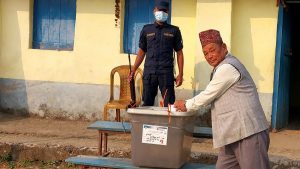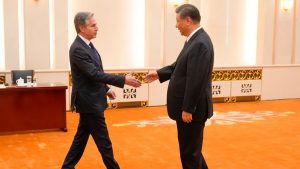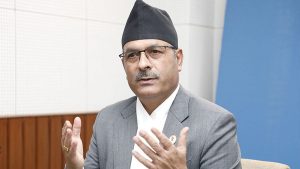
Debate Intensifies: Nepal Nears Signing of China’s BRI Agreement – Unveiling the Terms
The government of Nepal is poised to sign the implementation agreement for China’s Belt and Road Initiative (BRI) project, sparking intense debate and scrutiny within the nation.
Foreign Minister Narayankaji Shrestha is slated to ink the BRI implementation agreement during his imminent visit to China next week, as confirmed by high-level government sources.
Minister Shrestha’s impending five-day visit to China, commencing this Sunday, has raised eyebrows, especially as it marks his first foreign engagement since assuming office in the new cabinet.
Sources reveal that after protracted negotiations led by the Chinese side, Nepal is on the verge of finalizing the BRI implementation agreement.
In a clear indication of the project’s importance to China, the Chinese government has accorded priority to Nepal’s foreign minister’s visit, underscoring the gravity of the impending agreement.
Reliable sources disclose that Chinese Foreign Minister Wang Yi is scheduled to hold talks with Nepal’s Foreign Minister Shrestha on March 25 in Beijing, emphasizing the diplomatic significance of the visit.
However, amidst these developments, it is notable that Minister Shrestha’s enthusiasm for the BRI agreement appears subdued. Despite pressure from various quarters, including Prime Minister Pushpa Kamal Dahal Prachanda, to expedite the agreement process, Shrestha’s stance remains cautious.
The impending agreement has reignited discussions regarding the potential ramifications of Nepal’s deepening involvement in the BRI project, with concerns raised about sovereignty, debt sustainability, and environmental impact.
What is BRI?
The Belt and Road Initiative (BRI), an ambitious plan unveiled by China in 2013, has garnered global attention for its promise of infrastructure and economic development spanning across nations. However, the initiative has stirred controversy due to concerns over China’s increasing interventionist role.
With a vision to connect countries worldwide through extensive road and rail networks, the BRI has seen both praise and skepticism. China’s recent white paper highlighted its progress, citing cooperation agreements with over 150 countries and more than 30 international organizations as of June 2023.
Nepal, too, has not remained untouched by the BRI fervor, having signed a Memorandum of Understanding (MoU) with China in 2017. However, despite the initial agreement, substantial progress in project development related to BRI within Nepal has been notably absent.
Moreover, recent developments have raised eyebrows regarding China’s intentions regarding existing infrastructure projects in Nepal. Specifically, concerns have been raised regarding attempts to link the Pokhara International Airport, constructed with Nepalese loans, to the BRI framework without adequate consultation or consent.
This move has sparked debates within Nepalese political circles, with critics questioning the implications of such integration and its potential impact on Nepal’s sovereignty and economic autonomy.
What are the Chinese interests?
In the BRI agreement, policy exchange, infrastructure communication network, trade network, financial adjustment and people-level communication exchange were identified as areas of cooperation.
However, even after 6 years since the signing of the MoU, no project under this plan has been selected in Nepal. On the other hand, it has been found that they are trying to impose their dominant economy, terms and vested interests on Nepal through BRI.
Vinay Yadav, president of Rashtriya Ekta Abhiyan, demanded that the agreement be made public using his right to information rights. The details of the agreement provided to him by the government revealed China’s intentions and strategy.
The full text of the ‘Memorandum of Understanding (MoU)’ revealed many issues that the government and China had hidden. Section 3 of Chapter 2 of the Agreement deals with the expansion of trade relations. In which it is stated that both sides will study the possibility of China Nepal Free Trade Agreement within 2017 and if it is possible to start negotiations for the agreement to expand the trade and market of the two sides.
The agreement was signed on behalf of Nepal by the then Foreign Secretary Shankardas Bairagi and the then Chinese Ambassador to Nepal Yu Hong. At that time, the Prime Minister of Nepal was Pushpa Kamal Dahal, Chairman of CPN Maoist Center. There was a joint government of Maoist Center and Nepali Congress. Even now, Pushpa Kamal Dahal remains the Prime Minister.
According to the agreement, China, as the world’s second-largest economic power, appears to be seeking dominance over Nepal, aiming to operate its currency within Nepal and sell its goods and services in Nepal with zero customs duty.
In 2017, the Belt and Road Initiative (BRI) seemed to be attempting to monopolize the Nepalese market under the guise of ‘promotion of cooperation in areas of mutual benefit’. There was significant demand within Nepal for the agreement to be made public, but it was kept secret. The secrecy surrounding the agreement raised serious questions from various parties.
It is still unclear why the government of Nepal chose to keep the agreement confidential. The agreement aims to expand joint studies and promote cross-border physical projects including railways, roads, civil aviation, electrical transmission lines, information and communication systems, and strengthen cooperation in connectivity by enhancing collaboration in transportation infrastructure, transport networks, and network security.
The agreement stipulates that both governments can renew the agreement by providing three months’ notice. Similarly, it is mentioned that both parties can modify or amend the agreement as needed. Various transparency-focused associations and individuals have been questioning the decision to keep the agreement secret.















Comments